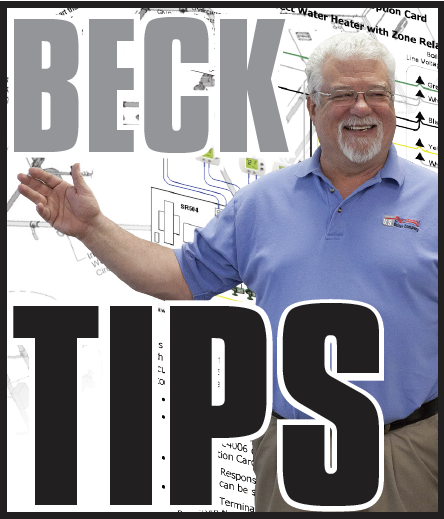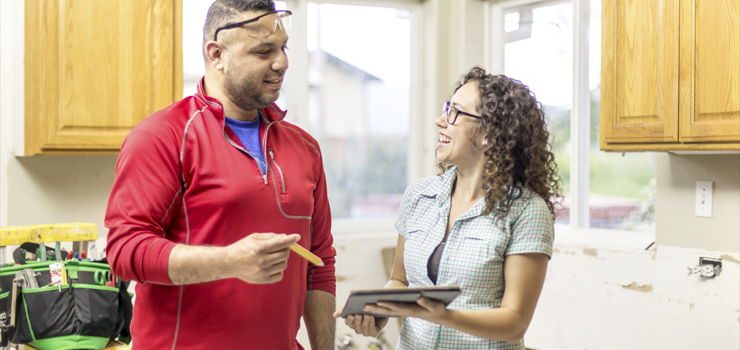 By Ron Beck, Outside Technical Advisor and Manager of Training for U.S. Boiler Company
By Ron Beck, Outside Technical Advisor and Manager of Training for U.S. Boiler Company
In our quickly changing industry, it can be a continuous struggle to keep up with advancing technology, trends and codes. And if you – who spends every day doing it – feel a bit overwhelmed at times, how do you think the customer feels? Everything they’re used to has changed in respect to heating equipment and options.
We need to start educating our customers and informing them about what to expect from a new heating system. This can solve a lot of problems! To help, I suggest having a checklist of information the consumer needs to be aware of to avoid any surprises after the installation. I knew a salesman from a heating company that carried a small photo album of finished installations so the customer could see what their new system would look like. The album included piping (broad view) and venting. The venting images show sidewall venting with the boiler running and not running in order to explain what a steam flume is.
Below are some homeowner talking points that come to mind. Depending on the type of equipment you install, it’s a good idea to make your own list and be ready to use it when the time comes.
Venting
- Chimney venting to sidewall venting: Remember, you are restricted by codes regarding where and how you can vent a heating system. If you have to install sidewall venting, you should discuss with the consumer what that is going to look like. Make sure they are aware of where it will terminate. If you can, offer them more than one option for where the vent penetration will be. If there’s only one option, explain why before cutting any holes. Do not vent under a deck due to ice build-up and deterioration caused by products of combustion. By code, you must terminate with the manufacturer supplied fittings or with options the manufacturer has certified.
- Noises: If you install sidewall venting, there can be some slight blower noise. Try to place the vent far enough from a neighbor’s windows to minimize noise. Many areas of the country require a minimum venting distance from a neighboring home. Additionally, sometimes venting may have to be installed through a different wall than the original heating system. It may also require hanging the boiler on a different wall and piping the system to the original boiler location.
- Steam Plume: If the vent termination is close to a window, let the homeowner know that there is a possibility the steam plume could blow across the window depending on air currents. The high efficiency boilers will produce more steam plume than cast iron units. Explain why there’s a steam plume and remind them that it’s steam, not smoke.
- Plants – Garden or landscape plantings in front of the vent pipe may die. If you need to, help them come to terms with this. A lot of folks are quite partial to their gardens and have spent a good bit of money on plantings. Make sure they know that they can’t block the vent with anything.
Gas Boilers 
- Trouble Codes: All gas boilers today have troubleshooting codes. Homeowners should not turn the power off and back on if there are error codes without making a note or taking a picture of any error codes.
- High efficiency boilers: All high efficiency boilers require annual maintenance. It is important to verify that all safeties are working properly, ignitors are clean and properly adjusted, and there are no water leaks. The boiler should be inspected and cleaned if necessary. Furthermore, regular maintenance keeps a boiler operating at full efficiency.
- Combi Boilers: Inform the homeowner that a combination boiler is different than a tank type water heater. Tank water heaters store hot water whereas a combi boiler produce hot water on demand. As a result, hot water will take slightly more time to reach the faucet when a combi is installed. The reason is that the boiler does not fire until the faucet is opened enough to achieve ½ GPM (gallon per minute) flow. Then, the boiler fires and runs a short time to create hot water. In short, receiving hot water at the faucet will take about 30 – 45 seconds longer than before. Adding a 5-6 gallon tank for domestic hot water can reduce this time.
Oil boilers

- Noise: Many times, the new oil burner makes more noise than the old oil burner. This is due to a little higher combustion noise and the possibility of the burner motors running at a higher RPM. Remind homeowners that the new oil boilers run more efficiently, so there is a trade-off.
- Ignition: New oil boilers have delayed ignition. This means when there is a demand on the boiler, you will hear the burner start but the flame will ignite a short time later. Remind them that this is done on purpose, and is not indicative of a faulty piece of equipment.
- Floor Space: The higher efficiency oil boilers, like our MPO-IQ, have a vent pipe that comes off the back of the unit. This will require extra floor space. That said, if their new boiler is properly sized, they may actually gain a little floor space.
Outdoor reset
- Cooler radiation: I hear about this a lot. The radiation will be cooler than what the homeowner was used to until it gets colder outside. Let them know that if the indoor air temperature is the same as the thermostat setting, the unit is working fine. Are they comfortable? If so, don’t worry about how warm the radiators are. For radiant floors, explain that they don’t necessarily need to feel a very warm floor. If the thermostat is reaching setpoint, things are working as intended. The system water temperatures will increase as outdoor temperatures decrease.
- Longer recovery times: Homeowners with outdoor reset who set their temperatures lower at night may notice that it takes longer to recover in the morning. If this bothers them, they should only set the thermostat back by 2°F or 3°F.
- Outdoor Sensor and wire: Make the customer aware of the outdoor sensor location, what they will see, and its purpose. Tell them it’s important that they do not tamper with it. This would be a great photo album picture!
- Discuss the Benefits of outdoor reset: The outdoor reset and sensor will create more comfort due to longer circulator run times at a lower water temperature which will save fuel. The system will operate quieter due to less expansion and contraction. This is a huge fuel saver for the homeowner! Remember, the outdoor reset is adjustable. You can adjust the control to supply warmer water in the shoulder seasons or hotter water earlier in the colder seasons.
Steam boilers
- Pipe insulation: All steam carrying mains must be insulated. If they’ve never seen insulated lines, they might wonder why you’re doing it. It is all about saving fuel and avoiding steam system noises. The suggested insulation wall thickness is 1” – 1-1/2”.
- Condensate pump or boiler feed tank: If they did not have one before, they may hear the condensate pump or boiler feed tank cycling. Verify you have it adjusted to run 45 seconds to a minute by adjusting a valve between the tank and the boiler. This will cause fewer cycles.
- Steam vents: The homeowner may hear vents hissing more as steam is being produced more rapidly. They should not hear the radiator vents. This is a sign of missing or non-working main line vents. In one pipe steam systems there should always be a big main line vent. Maybe include a replacement at the time of the installation.
General Operation
- Longer run times: If the boiler is properly sized the boiler will run longer run times. Explain to the homeowner that this means the boiler is operating more efficient with lower gas input.
- Circulators running, but the boiler does not try to fire: All cast iron boilers will delay start on a heat demand if the boiler water is higher than 140°F. The unit will fire after the boiler water temperature drops below 140°F or is below 140°F on the heat demand.
- Condensate pump/neutralizer: If there is going to be a condensate pump installed on the high efficiency boiler, discuss that they may hear it run occasionally and they will see water coming out of the tube. Do not terminate these pumps to the outdoors due to freezing. Explain what the condensate neutralizer is.
- Piping: After installation, the piping may look more complicated. This is especially true if the new boiler is piped primary/secondary and/or an indirect water heater is also installed where there was not one before.
Taking a little time with the customer on the front end can save you nuisance calls and visits on the back end!

